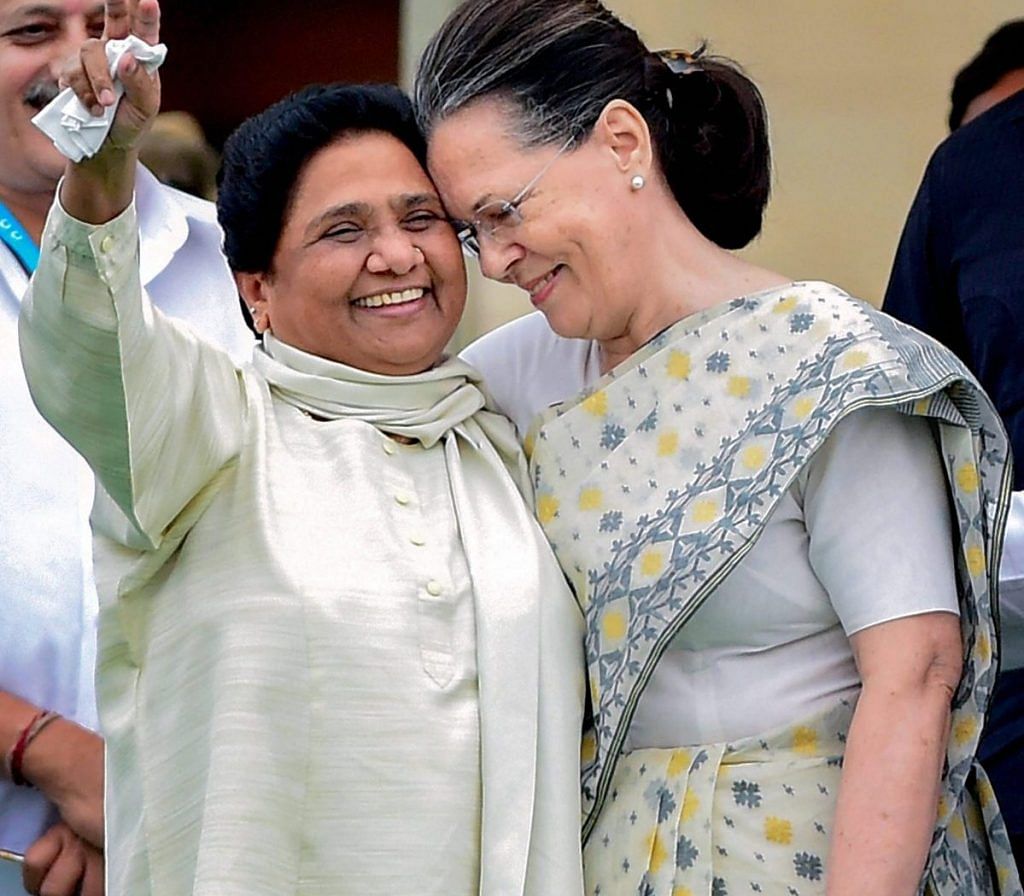Mayawati is best placed to be a sutradhar, and not the protagonist. If she were to declare she’s not in the race for the post of PM, her status as the tallest Dalit leader would make her the real power broker of opposition unity.
At H.D. Kumaraswamy’s swearing-in as the Karnataka chief minister Wednesday, he wasn’t the star of the moment.
The Bengaluru event became the biggest show of opposition unity in recent memory, bringing together many who don’t see eye to eye, such as the Trinamool Congress and the CPM. The star wasn’t Mamata Banerjee or Rahul Gandhi or even UPA chairperson Sonia Gandhi. It was Mayawati, who currently has all of zero seats in Lok Sabha.
In public display of affection carefully crafted for the cameras, Sonia Gandhi hugged Mayawati sideways. Not known for betraying emotions, Mayawati was forced to smile from ear to ear, clearly happy at the importance she thinks she deserves on the national stage. Sonia Gandhi held Mayawati’s hand and then raised it when all opposition leaders came together.
The symbolism cannot be missed. The Congress party is shedding its arrogance with regional leaders and is happy to play the junior partner, making H.D. Kumaraswamy chief minister here and propping up Mayawati’s hand there.
The project of opposition unity has received a big boost. Sonia Gandhi’s matronly presence with her generous and accommodating body language can go a long way in this project. Her presence also dented K. Chandrasekhar Rao’s efforts to create a “federal front” that excludes the Congress in taking on the BJP. Naveen Patnaik of Odisha also stayed away.
Opposition unity may have succeeded in preventing the BJP from taking over the reins of Karnataka, but challenges remain. There will be reluctant allies and internal contradictions. How can KCR and Naveen Patnaik join a grand alliance with the Congress while fighting the party in their respective states? Can the Congress really reach a pre-poll understanding with such an alliance given it is at odds with the Trinamool in West Bengal.
Even those who do not have such problems, have the bigger problem of wanting to be the prime minister. H.D. Deve Gowda, Mamata Banerjee, Mayawati, KCR are just some of the names who aspire to be prime minister.
If the opposition is to defeat the Modi juggernaut, it has no choice but to make sure there is only one opponent against the BJP on every Lok Sabha seat in 2019. Any division of votes automatically results in the BJP winning the seat. It is not just the arithmetic, though. Prime Minister Narendra Modi will attack the opposition as a rag-tag unstable coalition if it appears to be a divided house of cards.
The sutradhar
What the opposition needs, in both pre-poll and post-poll scenarios, is a sutradhar: someone who strings together these disparate beads into a thread.
This role can’t be played by the UPA chairperson, Sonia Gandhi, or any colleague of hers from the Congress party, because the Congress has ambitions to occupy the prime minister’s chair. Sonia Gandhi and the Congress can be the fulcrum, not the neutral sutradhar.
Harkishan Singh Surjeet was the ultimate kingmaker of coalition politics, the master puppeteer, the experienced sutradhar, because he and his party openly had no ambitions for the top job. Among regional leaders who don’t trust each other, with each eying the top job, Surjeet was the glue who bonded them together.
Surjeet played a pivotal role in bringing together every non-BJP coalition government from V.P. Singh’s in 1989 to UPA-1 in 2004. He passed away in 2008. Since then, his party, the CPM has been locked in a battle of personality and ideology. Prakash Karat, who drove his party to national irrelevance, and Sitaram Yechury, who thinks the party should play a national role, continue to be at loggerheads. The CPM or its leadership is in no shape to play Harkishan Singh Surjeet in 2018-19.
Sister of the alliance
Mayawati is best placed to play the role, if only she can keep aside her prime ministerial ambitions. Mayawati as a PM candidate would be a disaster as it would force a consolidation of upper castes and OBCs in favour of the BJP. Breaking news: they wouldn’t want a Dalit PM, certainly not someone like Mayawati with a mind of her own.
Mayawati, with zero seats in the Lok Sabha and only 19 in the Uttar Pradesh Vidhan Sabha, rises above all the other regional leaders. Her position as the tallest Dalit leader in Indian politics is unchallenged, and is not defined by how many seats she has.
Mayawati speaks rarely but when she does, her words carry weight. She can chastise the Congress for not doing a pre-poll alliance with the JD(S), which she backed in Karnataka, and still get sisterly hugs from Sonia Gandhi. She can publicly scold Akhilesh Yadav for being friends with Raja Bhaiyya, a don she doesn’t see eye to eye with, and Yadav deletes his tweet thanking the don.
Across India, Mayawati is looked up to by Dalit voters even if they don’t vote for her party. Voting is often about winnability, and Dalit votes alone can’t win the BSP a seat. But thanks to her position as an independent, important, and widely respected Dalit leader, she punches above her weight.
If Mayawati were to declare she’s not in the race for the post of PM, and would rather serve the cause of opposition unity, her status as the tallest Dalit leader would make her acceptable to all as the real power broker of opposition unity. She can be bigger than the PM’s chair, but it is unlikely she will be able to see beyond the ambition of the chair.
